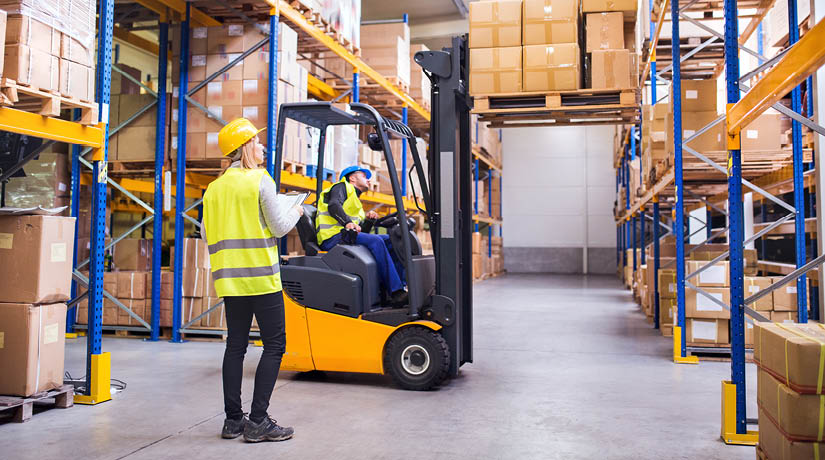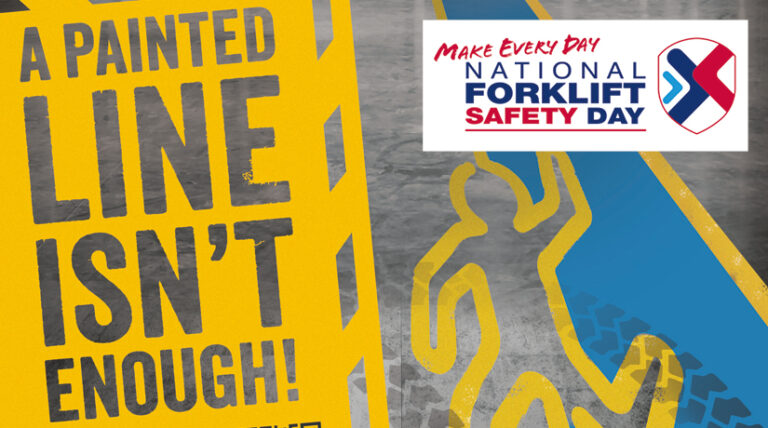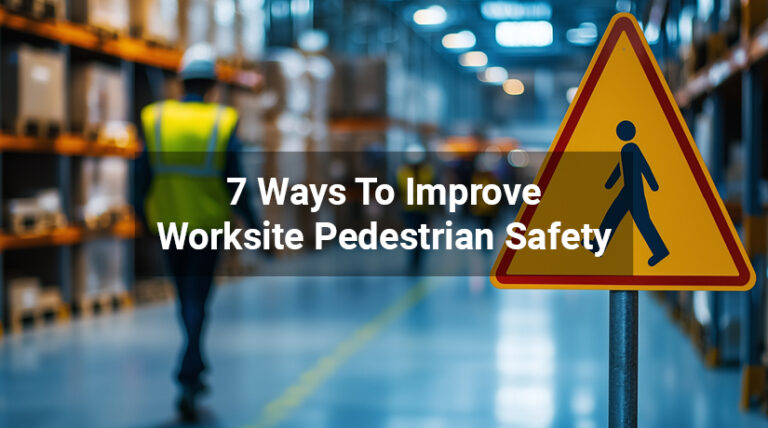A recent Forbes survey revealed that warehouse work is the third most dangerous job after firefighters and police officers. Common hazards include slips, trips, and falls, manual handling injuries, working at heights, and workplace transport accidents.
Employers have a legal and moral obligation to ensure pedestrian safety working around forklifts. Risk assessments and effective, safe working strategies must be implemented to reduce the chance of workplace accidents.
In this article, we offer safety tips to promote safe warehouse practices.
1. Implement Traffic Management Plans
Being struck by a moving vehicle is one of the most common types of fatal accidents at work in the UK. HSE 2022/23 figures show that 37% of fatal accidents in transportation and storage were due to being hit by a moving vehicle.
Segregation is the best way to combat this but is often difficult to achieve in a warehouse. Careful placement of floor markings, barriers and signage helps to create the divide, and pedestrian detection systems transforms pedestrian safety working around forklifts by creating segregation where it seems impossible. Traffic management strategies must be regularly reviewed to identify potential hazards and maintain pedestrian safety working around forklifts.
2. Regular Safety Training for Employees
Regular warehouse safety training arms everyone with the knowledge needed to understand risks, and emergency procedures.
Induction training introduces the company, its values and culture, and outlines safe warehouse practices and safety systems. Regular refresher training helps to check and refresh understanding.
Practical training provide hands-on scenarios that simulate possible safety incidents in a controlled way. It’s equally important to ensure all training records are kept up to date and easily accessible for investigations following an incident.
3. Proper Use and Maintenance of Equipment
The Provision and Use of Work Equipment Regulations 1998 (PUWER), places responsibility on organisations to ensure work equipment is safe to use. The regulations require businesses to ensure:
- Regular maintenance and up-to-date maintenance logs.
- Adequate training for equipment use
- Sufficient measures to control risks
Warehouses feature many types of manual handling equipment, including Forklifts, Conveyors, Cranes, Lift stackers, Pallet trucks and Automated Guidance Vehicles (AGVs).
It’s important that all equipment is kept in good working order with regular maintenance schedules and procedures for its use to ensure pedestrian safety working around forklifts. Only trained employees should use equipment, and up-to-date, regular training and procedures must be in place for its safe use. There must also be clear guidance for reporting damaged or faulty equipment to ensure pedestrian safety working around forklifts.
4. Emergency Preparedness and Response
All warehouses should have a robust emergency plan in place with clear communication to everyone. The plan should include:
• Roles and responsibilities in an emergency
• A list of key personnel
• A clear evacuation procedure
• Assembly points
• Alarm information
• Reporting procedure
Everyone should be aware of emergency equipment locations with clear signage in place. Regular emergency drills are necessary to refresh knowledge.
5. Enhancing Visibility and Lighting
Lighting plays an important role in warehouse safety. Warehouses often have few or no windows or natural lighting and work regularly occurs during hours of darkness.
Lighting systems should be strategically positioned to ensure adequate illumination, taking into account shadows and potential blind spots.
In some areas, automatic lighting and motion sensors work well. Activated signage also offers a great solution in dark corners and blind spot areas to grasp driver attention at the right moment.
High-visibility clothing helps workers stand out. ZoneSafe Proximity Warning System tags can be included as part of standard PPE to ensure pedestrians are ‘visible’ to drivers at all times and alert everyone to the chance of collisions before they occur. It is especially important within the warehouse to ensure pedestrian safety working around forklifts.
6. Safe Handling Practices
Manual handling accidents result in hundreds of serious injuries and work absences every year. The HSE guide; Manual Handling at Work: A brief guide, provides detailed information around correct techniques for lifting and handling heavy objects; the tools available to assist in manual handling; and how to prevent common manual handling injuries in the workplace.
7. Warehouse Housekeeping
Good housekeeping is often overlooked but is an important part of workplace safety initiatives.
Clutter and spills easily lead to slips, trips and falls, the leading cause of non-fatal accidents in UK workplaces. Poor housekeeping reduces visibility, increasing the chance of collisions and serious accidents.
Daily and weekly housekeeping routines should be established, and regular disposal of hazardous materials must be adhered to.
8. Use of Protective Gear
Personal protective equipment (PPE) is an important tool in worker protection. Wearers must have a good working knowledge of use, through regular training.
Policies regarding the use of PPE must be in place, and the equipment must provide appropriate protection for the activity it is being used for. ZoneSafe proximity warning tags are easily incorporated into standard-issue PPE to ensure pedestrian safety working around forklifts.
9. Reporting and Investigating Incidents
There must be a clear reporting system in place and workers must feel empowered to report, supported by a no-blame culture where everyone is listened to and every concern is followed up. Every incident should be seen as a learning opportunity with valuable data from each breach used to educate others.
10. Health and Wellbeing Programs
Most employers now recognise the importance of employee wellbeing and its impact on the workforce. Organisations prioritising health and wellbeing enjoy reduced employee sickness, greater workforce retention and increased productivity.
With this in mind, it is worth investing in worker wellbeing programmes including regular health checks and mental health support, all underpinned by a culture that promotes a strong commitment to overall health and safety.
There is no doubt the warehouse can be a dangerous place to work but many accidents can be avoided when safety measures are in place.
A safe workplace benefits everyone, ensuring there is little opportunity for accidents and injuries, and protecting the company from reputational and financial damage.
Contact ZoneSafe to discuss your pedestrian safety working around forklifts.




